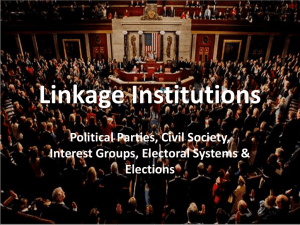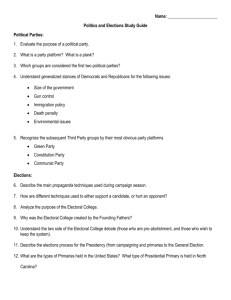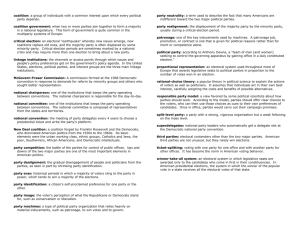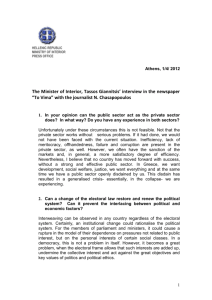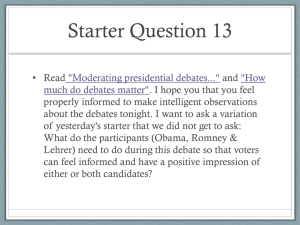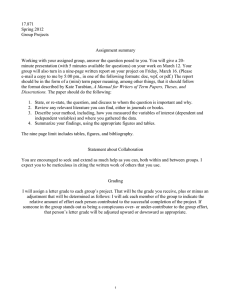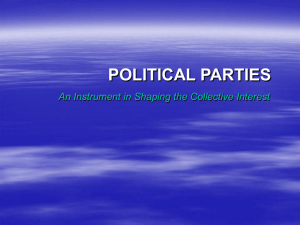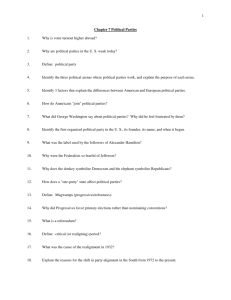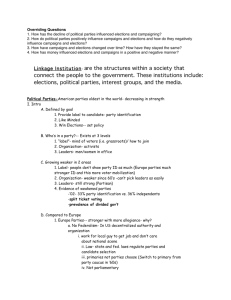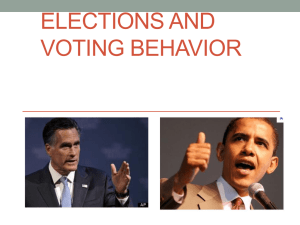Political Parties, Elections and Electoral Systems
advertisement
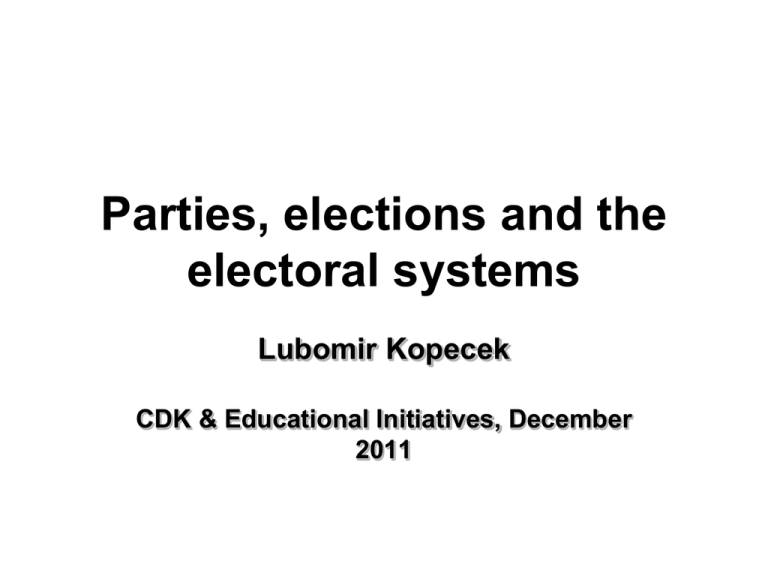
Parties, elections and the electoral systems Lubomir Kopecek CDK & Educational Initiatives, December 2011 Sense of parties • Political parties represent a vitally important link between the state and society. • The most important functions: representation and promotion of interests of voters. • Parties: necessary element of every representative democracy. state society What is a political party? • Minimal definition of Giovanni Sartori: a political grouping that takes part in elections, and through them is able to get their candidates into public offices. • Criteria of elections: distinguish political parties from other political actors (e. g. interest groups such as trade unions, business groups, etc.). Party competition • Party competition: fundamental attribute of every democratic regime. • Free competition among political parties: the citizen/voter freely chooses between at least two political parties > background of Schumpeter´s definition of procedural (electoral) democracy. • In dictatorships, government political parties usually function as an instrument of tyranny and repression: typically one-party system (only one legal party) or system of hegemonic party (other parties are subordinate to one party). Organisation of parties • Cadre parties: they did not seek to build a large membership base, extensive territorial structure and coherent program. • Mass parties: they have a large numbers of members, strong institutional structures with many local organisations (party machinery), and coherent program. • Catch-all parties: after WWII in Western Europe, changes of societies, the erosion of traditional social boundaries, and the growth of social mobility. • Catch-all parties: trying to attract socially very diverse voters, politically more moderate and less ideological, they became more professionalized, and more personalized. Party identity: party families • Common background of every party family: similar ideological values, programatic principles and historical origin. Selected families, their ideology and history • The social democrats and socialists • Great transformation: original identity after their appearance in the late 19th century was revolutionary radicalism, Marxist program, and rejection of the market economy. • Over time the social democrats adopted the principles of the liberal political order, and their Marxist program was gradually abandoned. • The vision of the so-called welfare state, with a large public sector and regulated market economy. Selected party families • Far left: in the 20th century was mostly shaped by the communists. • Ideology: the concepts of class struggle and a state based on the dictatorship of the proletariat, rejected political competition based on political plurality and the principles of liberal democracy. • Communist parties usually had link to the Soviet Union or China. • During time European communist parties shift in identity. Important moment: the breakup of the Soviet Union and Eastern block. • Today only a few of them are traditional communist parties. • Generally, politically and economically far left parties are still radical. However, they usually do not challenge the democratic regime. Selected party families • Christian democrats: the beginnings of these parties lie in the last decades of the 19th century. • Confession parties: Christian democrats were mostly Catholic in origin; parties with Protestant or other Christian origin were a minority. • At present the Christian democratic parties usually present themselves as ecumenical, and a large role in their identity is played by other elements such as family, morality, and traditional values. • Today they usually defend a social market economy. • Non-Christian religion parties exist outside Europe. Selected party families • Conservative parties strongly emphasize the importance of nation, state, defense of national interests, and traditional institutions, whether they be the monarchy, family, or local community (depending on the national context). • At present, most of the conservative parties are economically liberal. • Ethnic and regional parties emphasize defense of the interests of a particular region or ethnicity or both. • The goal of parties in this family may be to achieve greater autonomy for the given region, federalization of the national state, or full independence. Elections • The basic function of elections in a democracy is the selection of political representation. • Elections: a peaceful resolution of tension within society. • Through elections voters are mobilized on behalf of certain values, demands, or goals. Free elections • Four elements of elections : universal, equal, secret, and direct. • Universal: every person has the right to vote. • Equal: each person’s vote has the same value. • Secret: it is not possible to find out whom or what a person voted for. • Direct: the voter selects his representative. Electoral systems • Sense of electoral systems: transforming votes into mandates (seats). • Electoral systems influences the structure of the party system in the given country. • Two main types: majority and proportional. Majority electoral systems First past the post: many single-mandate district, the winner is the candidate who wins the most votes in district. The voter casts a single vote for his (or her) preferred candidate. Absolute majority: the candidate must win more than half of all the votes. If no one receives more than half of all votes in the first round, a second round is held between the two most successful candidates from the first round. Majority electoral systems, especially first past the post system, eliminate parliamentary seats for the minority (smaller parties) in favor of producing viable governing majorities: a clear winner – one party. The reduction of proportionality - small parties are mostly marginalized. The consequence is that majority electoral systems, especially first past the post, concentrate votes around major political parties and tend towards two-party systems. Proportional representation (PR) electoral systems • The essence of PR systems is proportionality. • The share of the vote for given parties to mirror closely the proportions of seats in the legislature. • On the other hand it produces the necessity of forming coalition governments. • The PR systems are most often founded on the system of party-lists. • However, PR is also more or less affected by the district size (number of seats in district), election threshold (e. g. 2 %, 4 %, 5 % etc.), or other specific factors.
